The human body is made up of many amazing organs, each with a special role. The heart pumps blood, the lungs help us breathe, and the brain controls our thoughts and actions. Among these, the liver is one of the most important organs. It works like a cleaning factory, removing harmful toxins from our blood and making substances that help in digestion. The liver also stores energy and supports our immune system. It is the largest internal organ and plays a key role in keeping us healthy. Taking care of our liver is essential for a healthy and active life.
Liver
The liver is a large, reddish-brown organ located on the right side of the abdomen, just below the ribcage. It is one of the most important organs in the human body. The liver helps clean the blood by removing toxins and harmful substances. It also produces bile, a liquid that helps digest fats in the food we eat. Additionally, the liver stores energy in the form of sugar (glucose) and releases it when the body needs it. It also plays a role in making proteins and supporting the immune system. Without the liver, the body cannot function properly, making it essential for good health.
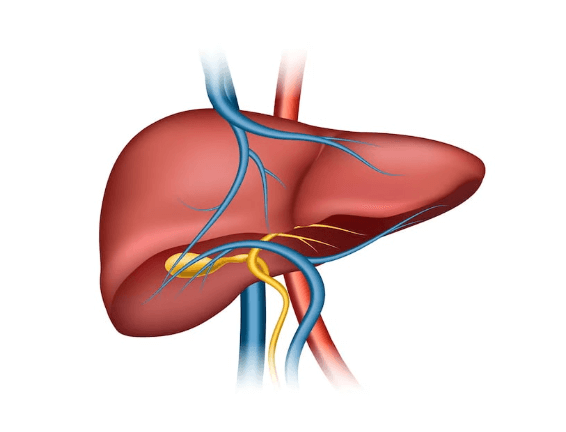
Liver Diagram
A diagram of the liver shows its structure and connections to other organs. The liver is shaped like a wedge and is divided into two main parts, called the right and left lobes. The gallbladder is located underneath the liver, storing bile produced by the liver. You will see blood vessels like the hepatic artery (bringing oxygen-rich blood) and the portal vein (carrying nutrient-rich blood from the digestive system). Bile ducts connect the liver to the gallbladder and small intestine. The diagram often includes labels for these parts, showing how the liver plays a central role in digestion and blood filtering.
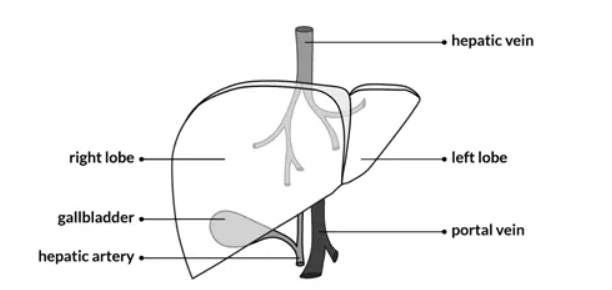
Structure of Liver
The liver is a vital organ located in the upper right abdomen, just below the diaphragm. It has a unique structure that supports its diverse functions, including detoxification, metabolism, and bile production. This intricate structure allows the liver to efficiently perform its metabolic, synthetic, and detoxifying functions. Here’s an overview of its structure:
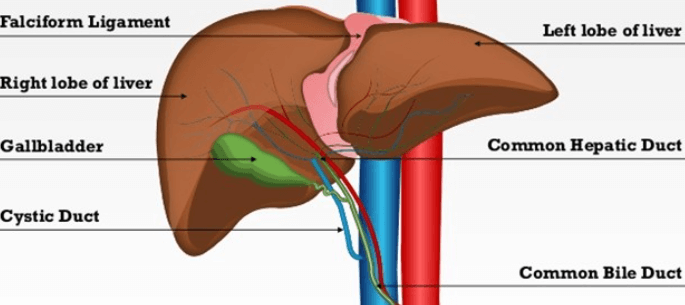
External Structure
The liver is a reddish-brown organ with a smooth surface, located in the upper right abdomen. It is covered by a thin protective layer called the Glisson’s capsule. The liver has two main lobes: the right lobe, which is larger, and the left lobe, which is smaller. Its upper surface is curved to fit under the diaphragm, while the lower surface is irregular with grooves where other organs like the stomach and gallbladder rest. Blood vessels and the bile duct enter and exit at the hilum (porta hepatis).
Shape and Size:
The liver is wedge-shaped and weighs about 1.2–1.5 kg in adults. It has a reddish-brown color due to its rich blood supply.
Lobes:
The liver is divided into two main lobes i.e., the Right lobe and left lobe. Additional smaller lobes include the caudate and quadrate lobes.
- Right Lobe: Larger and more prominent.
- Left Lobe: Smaller and extends toward the left side.
Surfaces:
- Diaphragmatic Surface: Convex and smooth, facing the diaphragm.
- Visceral Surface: Concave and irregular, facing the abdominal organs. It houses structures like the gallbladder and major blood vessels.
Internal Structure
The internal structure of the liver is made up of tiny functional units called lobules. Each lobule is shaped like a hexagon and consists of liver cells (hepatocytes) arranged in plates. These cells are responsible for filtering blood and producing bile. The lobules are surrounded by blood vessels, including the hepatic artery and portal vein, which supply blood to the liver. Small channels called sinusoids carry blood through the lobules, and bile canaliculi collect bile produced by hepatocytes. All these structures work together for liver functions.
Lobules:
- The liver is composed of functional units called lobules.
- Each lobule consists of hepatocytes (liver cells) arranged in hexagonal structures.
- Central veins run through the middle of each lobule, collecting blood.
Blood Supply:
- The liver receives blood from:
- Hepatic Artery: Supplies oxygenated blood.
- Portal Vein: Brings nutrient-rich blood from the digestive system.
- Blood flows through sinusoids (small capillaries) where it is processed and detoxified.
Bile Production:
Hepatocytes produce bile, which is collected by bile canaliculi and transported to the bile ducts.
Connective Tissue:
The liver is surrounded by a thin capsule of connective tissue called Glisson’s capsule. It extends into the organ, supporting its structure.
Regeneration of Liver
The liver is an amazing organ because it can regenerate itself. If part of the liver is damaged or removed, the remaining liver cells grow and divide to replace the lost tissue. In humans, the process of regeneration occurs between 8-15, whereas in mice, the same process takes around 5-7 days.
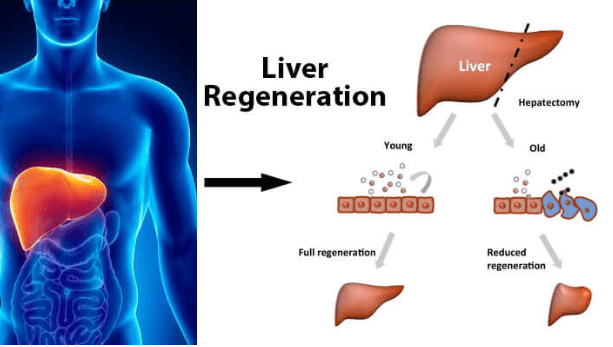
This process helps the liver recover and continue its important functions, like removing toxins and making vital proteins. Even if up to 70% of the liver is removed, it can grow back to its normal size in a few weeks. However, this regeneration depends on good health and avoiding harmful habits like drinking alcohol. The liver’s ability to heal itself is a unique feature that helps keep our body healthy, but we must take care of it to ensure it works properly.
Functions of Liver
The liver is vital for overall health and performs over more than 500 different functions in the human body. Some of these have been discussed below.
- Detoxification: The liver removes harmful substances like toxins, alcohol, and drugs from the blood.
- Production of Bile: It produces bile, which helps in the digestion and absorption of fats in the small intestine.
- Metabolism: The liver processes nutrients absorbed from the digestive system, converting carbohydrates into glucose and storing excess glucose as glycogen.
- Storage: It stores vitamins (A, D, E, K, and B12) and minerals like iron and copper.
- Blood Regulation: The liver helps maintain blood sugar levels and produces essential proteins like albumin and clotting factors.
- Immune Function: It acts as a filter, removing bacteria and old blood cells, contributing to immune defense.
- Cholesterol Regulation: The liver synthesizes and regulates cholesterol levels in the body.
- Hormone Processing: It processes hormones, ensuring balance and breaking down excess hormones.
Liver Diseases
Liver diseases refer to a range of conditions that affect the liver, a vital organ responsible for functions such as detoxifying harmful substances, producing bile, and storing nutrients. Some common liver diseases include:
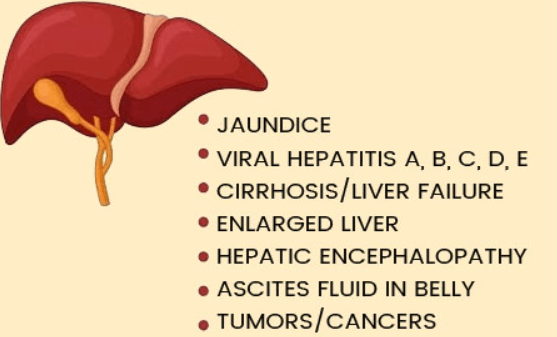
| Liver Diseases | |
| Diseases | Description |
| Hepatitis | Inflammation of the liver caused by viruses (Hepatitis A, B, C, etc.), excessive alcohol use, or autoimmune disorders. |
| Fatty Liver Disease | Accumulation of fat in liver cells, often due to obesity or excessive alcohol consumption. |
| Cirrhosis | Irreversible scarring of the liver caused by prolonged damage from alcohol, chronic hepatitis, or other conditions. |
| Liver Cancer | Malignant tumors, such as hepatocellular carcinoma, can develop due to chronic liver diseases. |
| Liver Failure | A life-threatening condition where the liver loses its ability to function, caused by diseases, toxins, or severe infections. |
Symptoms
Fatigue, jaundice (yellowing of the skin and eyes), abdominal pain, swelling, and dark urine.
Prevention and Treatment for Liver Diseases
Maintaining a healthy lifestyle, avoiding excessive alcohol, vaccination for hepatitis, and timely medical interventions like medications or surgery. Early diagnosis is critical for managing liver diseases effectively. Prevention and treatment of liver diseases focus on maintaining liver health and addressing specific conditions. Consult a healthcare professional for personalized advice and early diagnosis to ensure effective management. Here’s an overview:
Prevention
- Healthy Diet: Eat a balanced diet rich in fruits, vegetables, whole grains, and lean proteins. Avoid excess sugar and unhealthy fats.
- Limit Alcohol: Reduce or avoid alcohol consumption to prevent liver damage.
- Vaccination: Get vaccinated for hepatitis A and B to lower the risk of viral infections.
- Avoid Toxins: Minimize exposure to chemicals, such as pesticides and harmful cleaning agents, which can harm the liver.
- Regular Exercise: Stay active to maintain a healthy weight and prevent fatty liver disease.
- Medicines: Use medications responsibly, as some drugs and supplements can harm the liver when taken in excess or without medical advice.
Treatment
- Lifestyle Changes: Adopting a healthier lifestyle can reverse early-stage liver diseases like fatty liver.
- Medications: Specific drugs can treat hepatitis or manage symptoms of liver conditions.
- Surgery: For advanced diseases, procedures like liver transplantation may be necessary.
- Antiviral Therapy: Used for viral hepatitis to control or eliminate the infection.
- Monitoring and Support: Regular check-ups and supportive care for chronic liver diseases like cirrhosis.

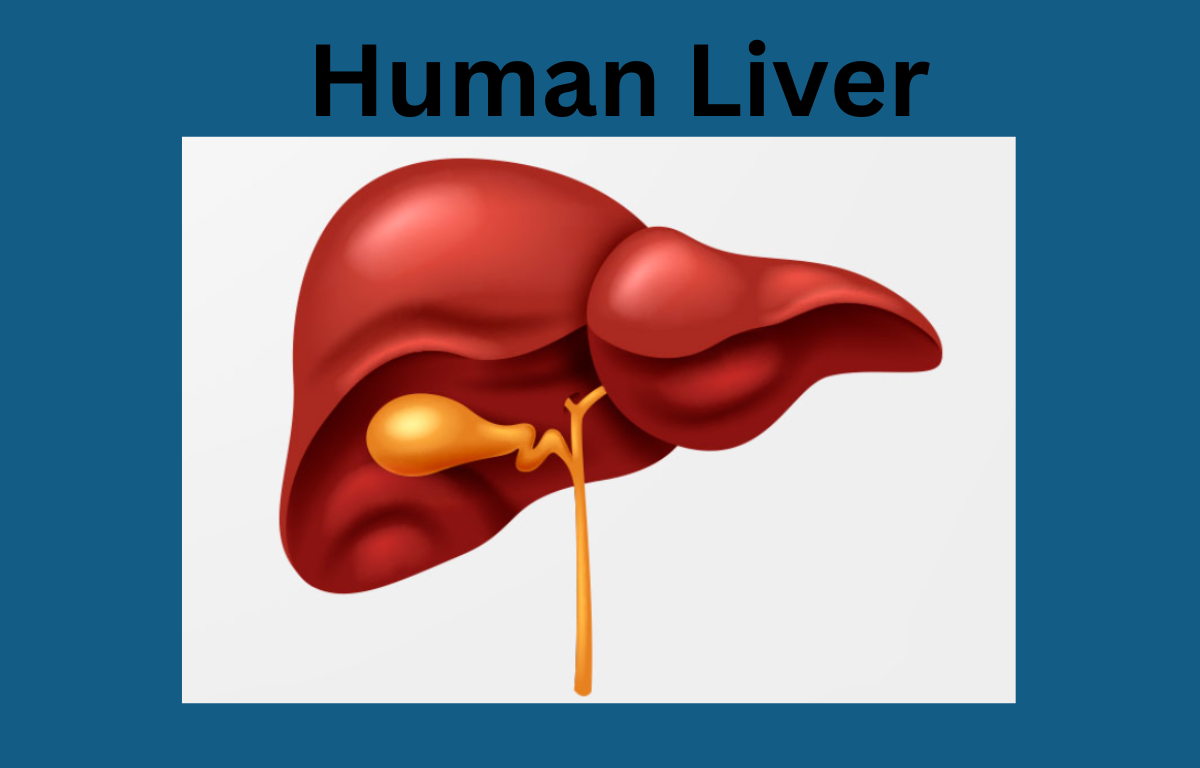

 50 Vegetables Name for Kids in English a...
50 Vegetables Name for Kids in English a...
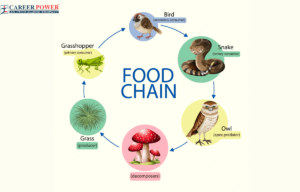 Food Chain: Definition, Types, Examples,...
Food Chain: Definition, Types, Examples,...
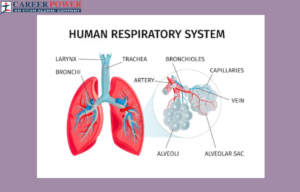 Human Respiratory System: Definition, Di...
Human Respiratory System: Definition, Di...













